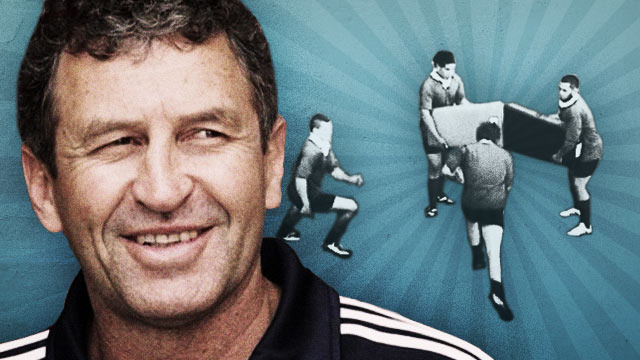Chiefs support play
“The way you position your players in support allows you to get continuity, retain possession, add pace to the game and play 15-man rugby”. That is what Wayne Smith has to say about the importance of support play in the introduction to his coaching module.
Support play is like a ligament or tendon in the human body, the essential link between the start-point of an attack (typically a line-break) and the end result (a try). Without it there is no connection between bone and muscle and there is far less chance of a score.
The Super rugby match between the Brumbies and Chiefs provided some excellent illustrations of the techniques and attitude Wayne Smith recommends in support play processes.
In this example the Chiefs #9 Brad Weber has supported an initial line-break by #15 Damian McKenzie and he immediately fulfils Wayne Smith’s first two cardinal rules of support play:
1. Straight lines. The ball-carrier must get on a straight line as soon as possible. As soon as Weber receives the pass from McKenzie, he makes sure he takes the shortest route towards the opposition goal-line – he starts about 5 metres inside the 15m line and stays on the same line until the last three strides.
2. Trailing support. In his trailing support drill, Wayne Smith suggests that the ball-carrier should attempt to take the defender away from the point of attack at the last moment, pulling him off the straight line of attacking support. The ball-carrier moves off straight only two or three strides away from the defender, which makes the defensive reaction ‘automatic’. So at 27:32, Weber makes a late adjustment to his right, taking three Brumby defenders with him – Matt Toomua, Christian Leali’ifano and Robbie Coleman. This levers open the space for the support player, Aaron Cruden, to continue straight upfield at 27:35 after the switch pass inside.
As second example only one minute later provided further reinforcement of the core values of support play:
Here the Chiefs left wing James Lowe makes a break down the side-line before delivering a lateral offload to Aaron Cruden supporting inside him. Although the two players are roughly level with each other when Cruden receives the ball at 28:42, only two seconds later Lowe has dropped into the pocket directly behind his team-mate, which as Wayne Smith says represents the sweet spot for any player backing up in support. He calls it ‘moving from a lateral to a deep support position’ – the process resembles the drill for cleanout, with the support player switching channels so that he can enter ‘through the gate’ successfully.
Lowe also obeys the third rule of the module:
3. Maintaining depth in support. Maintaining depth on support, about 2-3 metres behind the ball-carrier, is key to allowing him the time and space to make decisions with ball in hand. The support player reacts to the ball-carrier’s decision, not vice-versa. In this example James Lowe is in exactly the right position to react to Cruden’s choice of pass, about 1.5 metres off the ball and directly behind the passer. Once again, Cruden ‘wiggles’ off line in the last three strides to pull two Brumby defenders with him and create free passage upfield for Lowe to score the try.
The Chiefs also provided a live illustration of the four-man ‘box’ drill Wayne Smith describes in his module right at the end of the first half:



The ball-carrier (“#1” Charlie Ngatai in the black hat) has a support player alongside him (“#2” in the drill, here Brad Weber), with “#’s 3 & 4” (McKenzie and Cruden) supplying the depth and completing the box. In the event Ngatai passes to a fifth man, Lowe flying up on the left!
The final example from the Chiefs match with the Brumbies occurred deep into the final quarter:
Here James Lowe has chipped ahead and picked up a favourable bounce before the Brumbies’ defence can collect the ball and snuff out the threat. As soon Lowes re-gathers at 66:43 he has McKenzie trailing in the pocket behind him and maintaining a good two metres of depth.
When McKenzie receives the offload at 66:46 we have a portrait of picture-perfect support! Both lateral support (Weber to McKenzie’s right) and trailing support (13 Anton Lienert-Brown) are available. In the event McKenzie chooses the obvious and correct pass to Weber, but he could just as easily have ‘wiggled’ to draw the last defender and put the trailing runner through for the try. There is a slight deceleration as McKenzie approaches the Brumby full-back so that all the options are in prime position and the ball-carrier is not isolated.
Summary Modern statistics usually register the number of line breaks that have been created by an attacking team, but there is no stat for successful support play other than the number of line breaks that were converted into tries.
Sometimes coaches often stop at the creation of line breaks when the process of their conversion is arguably even more important. The phrase ‘being clinical at finishing opportunities’ in fact describes the amount of coaching input into support play. It has nothing to do with luck, it is linked to the strength of the desire to adopt the accurate support methods Wayne Smith talks about in his module, and Chiefs’ performance of them in live matches.


